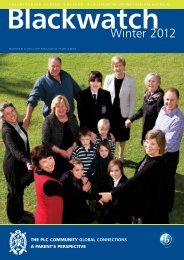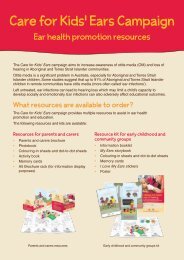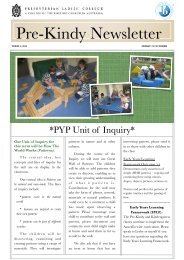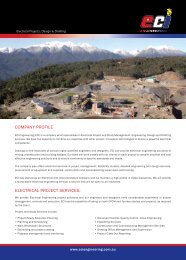Cystic Fibrosis - Aussiehome
Cystic Fibrosis - Aussiehome
Cystic Fibrosis - Aussiehome
- No tags were found...
Create successful ePaper yourself
Turn your PDF publications into a flip-book with our unique Google optimized e-Paper software.
<strong>Cystic</strong> <strong>Fibrosis</strong>Information for schoolsand the community<strong>Cystic</strong> <strong>Fibrosis</strong> WAnity
ContentsIntroduction 1What is cystic fibrosis? 2- How common is cystic fibrosis?How does cystic fibrosis affect the body? 4- Respiratory system: lungs- Digestive system: pancreas- Sweat glandsTreatment for cystic fibrosis 6- Treatment for the lungs- Intravenous (IV) medications- Hospitalisations- Digestion- Gastronomy tubeEnzyme capsules 8The cystic fibrosis diet 9Social and psychological issues 10<strong>Cystic</strong> fibrosis and cross infection 11- Infections from other people- Cross infection between people with cystic fibrosisConsiderations for schools 12- Communication between the school and the family- Hospital school services at PMH- Intravenous (IV) line- Outings and overnight trips- Phys Ed- Regular toilet breaks- Should the child’s peer group know?- Time off school- What about discipline?Further reading, resources and contact details 14- Websites for CF information- Books available in the CFWA library to loan- Additional contacts- BibliographyAppendix 151. Example of things for teachers to consider in amedical healthcare plan2. Information sheet for relief teachers3. Example of enzyme recording chart
IntroductionHaving a child with cystic fi brosis in your care means that you are interacting with a child whohas a chronic illness, a condition that has no effect on intelligence, does not interfere with achild’s ability to participate fully and is not contagious.You can have the same expectations in the classroomor social setting of a child with cystic fibrosis as youwould of any other child.There is no typical child with cystic fibrosis. Thedisease affects each child in different ways withvarying degrees of severity, and each child’s healthcan change considerably from month to month orday to day.Almost all children with cystic fibrosis show somesymptoms of the disease. Typically they live withmild, moderate or even severe lung disease andgastrointestinal problems. Children with mild ormoderate cystic fibrosis usually appear healthy, butthis appearance can be very misleading.The best way to help children with cystic fibrosisat school or in the community is to treat them asindividuals and to be receptive to their changingneeds.This booklet has been designed to assist teachers,teacher assistants, staff in primary and secondaryschools, daycares and other community groups aswell as other parents, to understand cystic fibrosisand how it affects the child concerned.cystic fibrosis<strong>Cystic</strong> <strong>Fibrosis</strong> in the Community<strong>Cystic</strong> <strong>Fibrosis</strong> WA 01
What is cystic fibrosis?<strong>Cystic</strong> fi brosis is one of the most common life-threatening, recessive genetic conditions inAustralia. It primarily affects the lungs, digestive system and sweat glands. CF can also affect thereproductive system in males and to a small degree in females.<strong>Cystic</strong> fibrosis (CF) is not curable at the moment,however a great deal of resources are being directedtowards finding new and improved ways of treating itand working towards finding a cure.CF is a condition in which there is considerable variationin the severity of symptoms. CF was first recognised asa specific condition in the 1930’s at which time mostbabies born with the condition had a very short lifespan.Today with earlier diagnosis, greater understanding ofthe condition, improvements in treatment and bettermanagement, the majority of children live well intoadulthood, many leading independent and successfullives.How common is CF?• In Australia there are approximately 80 babies born withCF each year.• The incidence is 1 in every 2500 births.• 1 in 25 people are carriers of the CF gene• There is a 1 in 400 chance of two carriers forming arelationship• If two people are genetic carriers for CF and they have achild, there is a 25% chance that their child will have CF.• There are approximately 3000 people with CF in Australia.• The are approximately 300 people with CF in WesternAustralia• 50% of the CF population in WA are adults• CF is most common amongst Caucasian races.FatherCF CarrierMotherCF CarrierA diagram showing how theCF gene can be passed on tooffspringUnaffected ChildNot a CF CarrierUnaffected ChildCF CarrierUnaffected ChildCF CarrierChild withCF02<strong>Cystic</strong> <strong>Fibrosis</strong> in the Community
<strong>Cystic</strong> <strong>Fibrosis</strong> WA 03
How does cystic fibrosis affect the body?A person who has cystic fi brosis will be missing a functional protein from his or her cells. Thismeans that chloride and sodium cannot be properly transported across the cell membrane. Thiscauses mucus (which everyone has in their body) to become thicker and stickier than normal.The mucus then builds up in organs like the lungs and pancreas. Other complications from CFmay include fatigue, chronic sinusitis, asthma, late onset of puberty, CF-related diabetes, livercirrhosis and male infertility.Respiratory system: lungsThe effects of cystic fibrosis are very individual. Not allpeople with CF have the same complications or symptomsor require the same care.For the majority of people with CF, complications in therespiratory system are the most serious. Respiratoryfailure is usually the most common cause of death. Thick,sticky secretions interfere with the body’s natural processof clearing infectious material away ay from the lungs. Themucus clogs the breathing passages and if not cleared,can lead to recurrent lung infections ns and lung damage.A child with CF may have the following respiratorysymptoms;- chronic coughing (not contagious)- mucus (sometimes tinged with blood)- shortness of breath or wheezing(due to low lung function)- pale appearance- frequent respiratory infections ns or fluGall BladderLungsLiverDuodenumStomachPancreasColon04<strong>Cystic</strong> <strong>Fibrosis</strong> in the Community
Digestive system: pancreasThe pancreas is a gland just below the stomach and oneof its functions is to produce enzymes which break downfood so that it can be absorbed by the digestive system.With CF the sticky mucus can make it difficult for theenzymes to reach the small intestines to break down foodso nutrients can be absorbed. As a result fats and proteinsare poorly absorbed and this is known as malabsorption.Children and adults with CF usually have great difficultygaining weight. A diet high in fat is recommended fora child who has CF.The pancreas also produces insulin. Later on, some peoplewith CF may require insulin supplementation, withoutthe need to change their diet. Symptoms of CF relateddiabetes may include thirst and frequent urination.A child with cystic fibrosis may have:- excessive or poor appetite- poor weight gain, small size and distended belly- occasional flatulence and stomach cramping- foul-smelling, excessive or urgent stools- a need for extra toilet privileges and extendedtime needed in the toiletAbout 10% of people born with CF have relatively normalfunctioning digestive systems.Sweat glandsPeople with CF lose 3-4 times more sodium (salt)through the sweat glands than those without CF, so theirdaily need for this essential mineral is high, approximately4000-6000mg minimum daily for adults, although thisvaries between individuals.People with CF require a diet high in salt in order to limitthe risk of dehydration and they need frequent drinks ofwater or salty drinks such as Gatorade.Salt depletion can happen very quickly during a hot daywith prolonged exertion. Drinking plenty of water andtaking salt supplements is important especially during andafter sports activities.Symptoms of dehydration and salt depletion include:- loss of appetite- tiredness, listlessness- grumpy or irritable- difficulty concentrating- headaches- cramps- thirst- sunken eyes- nauseaThe main diagnostic test for CF is the sweat test whichmeasures the level of salt in the sweat. If you were to lickthe face or neck of a person with CF they would taste verysalty!cystic fibrosis<strong>Cystic</strong> <strong>Fibrosis</strong> WA 05
Treatment for cystic fibrosisThe treatment for cystic fi brosis involves a team of medical and allied health professionalsincluding doctors, nurses, physiotherapists, dieticians, pharmacists, psychologists and socialworkers. In between periods of hospitalisation and clinic visits, families take on the roleof managing routine treatment and therapy. Once a child reaches adolescence he or she isencouraged to manage their daily home treatment independently.Treatment for cystic fibrosis can be intensive and timeconsuming. It is ongoing and lifelong. At present,treatment is aimed at slowing the progression of thecondition. The type of treatment required may vary duringthe year, depending on whether the child is having anexacerbation (a worsening of lung condition) or a “well”period. Children or adults with CF may be on antiinflaminmatorymedications, antibiotics, steroids and/orbronchodilators. These medications may be given orally,intravenously, through metered dose inhalers or in aerosolform using a small-volume nebuliser.Treatment for the lungsEach day, most people with CF follow a treatment routineto control the accumulation of potentially harmful mucuson the lungs. Since CF affects each individual differently,the therapy prescribed for one child by his/her physicianmay not be appropriate for another person with the samecondition.The treatments that help to clear abnormal mucus includeairway clearance and inhalation of medications. In airwayclearance, a mixture of percussion, vibes and breathingexercises are used to clear the lungs and dislodge smallmucus plugs in the airways. Chest therapy is usuallyperformed twice a day; once before school and perhapsupon arriving home or before bedtime.Increased physical education participation is medicallybeneficial, even though some children may cough a lot.This coughing helps to remove the mucus from their lungsso exercise tolerance may be decreased and needs to betaken into consideration.Intravenous (IV) medicationsMost children or adults with CF periodically requireintravenous (IV) medications in addition to their dailyhealth regime. Quite often the child’s parents are ableto administer the IV antibiotics at home, through aPeripherally Inserted Central Catheter (PICC) line in thechilds arm. The line is sealed and covered by a bandagewhich enables the child to continue at school instead ofstaying in hospital.HospitalisationsMost adults and children with CF in Western Australiaattend regular clinic sessions at Princess Margaret Hospital(for children) and Sir Charles Gairdner Hospital (for adults).It is also common for people with CF to visit the hospitalfor a two week period for what is often called a “tuneup”. During the two weeks the person will receive extraIV antibiotics, chest therapy and their diet may be assessedby a dietician.DigestionTo improve absorption of food most people with CFrequire enzyme replacement capsules with meals andsnacks. These enzymes pass into the stomach and act likethe body’s natural enzymes by breaking down food andincreasing absorption in the small intestine.Enzymes are not drugs, they are supplements. Enzymesneed to be taken before eating a meal. They are notdangerous to other children.To improve nutrition and maintain body weight a diethigher in fat and calories is required. Some people mayalso require other supplementary vitamins.Gastrostomy tubeSome children have a gastrostomy tube to help withsevere malnutrition. This is a feeding tube that goesdirectly through the abdominal wall into the stomach.A plastic button sits on the outside of the abdomen.Liquid nourishment and certain enzymes can beadministered through this button. This is rarely done whenthe child is at school. Please note that in some instancesthe tube can become dislodged.06<strong>Cystic</strong> <strong>Fibrosis</strong> in the Community
tm<strong>Cystic</strong> <strong>Fibrosis</strong> WA 07
Enzyme capsulesA child or adult with cystic fi brosis may take capsules containing pancreatic enzymes with theirmeals and snacks. These enzymes help the body to absorb nutrients from food and to reducethe number and bulk of stools, the amount of fl atulence and abdominal pain and distension.Most children who need to take enzyme capsules havebeen taking them since infancy and can take them ontheir own. There is no need to lock these medications ina desk or store them in an office, however they do needto be kept in a cool, dry place under 25˚C. In most cases,depending on the child’s age and maturity, he or she cancarry the day’s supply in their lunch box and take themwith their lunch and snacks. Parents should be responsiblefor providing the number of capsules required and aproper storage container to keep them in.Children with CF are encouraged to manage their ownpancreatic enzyme replacement therapy once they reachthe age of six or seven, depending on the child. Youngchildren may require a level of supervision to ensure theytake their enzymes at the appropriate times.The enzyme capsules are not habit forming or lifethreatening if taken by another child and will not alter thechild’s attitude or emotional behaviour. A person with CFmay need to make a quick exit to the toilet and flatulencecan be odorous and embarrassing. sing.The capsules are only effective for 30minutes. If a meal islonger than 30 minutes additional enzymes must be taken.(It is preferable to take the capsules prior to eating and tofinish the meal within half an hour, but they can be takenafter the meal)If enzymes are not taken, the immediate iate consequence isreduced absorption of food resulting in stomach pains,wind and diarrhoea.The dose of enzymes required depends ds on the individualand the type of food eaten.The way that parents calculate how many enzyme capsulesto give to their child before a meal depends on thestrength of the capsules. They come in strengths of 5000which equates to 1 capsule per 4g offat or 10000 whichis 1 capsule per 8g of fat.The capsules are only to be consumed with food thatcontains fat and proteins. There is noneed for a child withCF to take them with the following foods:• fruit juices • cordial and soft drinks• lollies• jelly • fruit • icy poles• sugar • salad and leafy vegetables • jam and honeySome children and adults prefer to take their enzymecapsules with a drink.Be aware that some children with CF, may feelembarrassed about taking their capsules in front of theirclassmates at school, or friends and may ‘forget’, hide orthrow away their enzyme capsules or miss their meals.Good communication with the parents of a child withCF is essential to put their minds at ease – it can be quitestressful managing their child’s daily medication and CFtreatment.If a child takes too many capsules for the amount of foodconsumed in a couple of instances it is not dangerous, butin some cases, this could be harmful over a long period oftime.If the child doesn’t eat their food or snacks they do notneed to take the capsules, however parents should benotified of this, as a child with CF has to eat a certainamount of food per day.08<strong>Cystic</strong> <strong>Fibrosis</strong> in the Communitymunity
There are a number of different ways that parentscommunicate with teachers and their children as tohow many enzymes to take with which foods, whileat school.- Some parents write on labels the amount of enzymesneeded and stick them on to the appropriate fooditems.- Some parents may use a communication book, wherethe child or teacher (or both) record what was eatenand how many capsules were taken.- Some children are able to take their capsulesindependently and require very little assistance. Thisshould be encouraged.- Some parents may provide a short list of the typicalfood items that a child may eat at school eg. hamand cheese sandwich, chocolate bar and packet ofchips. Next to the different food items there will be theamount of capsules needed.- Sometimes a teacher’s assistant will monitor the studentwhile he or she takes their capsules.- Please take the time to discuss a plan with the parent asto what type of system will work for their child and foryou as the teacher and your school.- Consider what you will do if your student eats theirlunch in an open area where there are different teachersdoing lunch duty each day. How will you inform anyrelief teachers about the routine? Ask the parent aboutclass parties, how many capsules will be needed?Enzymes for babies:- To give enzymes to babies and young children whoare not able to swallow capsules, parents open thecapsules and mix the granules with apple puree or fruitgel. They use up to ½ a teaspoon of apple to cover theenzyme granules.- It is advisable to check the baby’s mouth and gums forleft over granules at the end of each feed and removethem. Granules left in the mouth after a feed can causemouth ulcers.The cystic fibrosis dietPeople with cystic fi brosis require extra calories for energy because of the demands that CF placeson the body. The lungs need to work harder and the nutrients consumed are not always absorbedproperly. Therefore people with CF are encouraged to eat a high energy, nutritious diet followingthe Dietary Guidelines for Children and Adolescents with CF.The energy requirements ofa person with cystic fibrosiscan be 20-50% more thanpeople of the same age toachieve normal growth. This does not mean that an adultor child with CF has to consume 20-50% more food intheir diet, they need to findways of adding extra caloriesor kilojoules into the foods they normally eat (such asadding more butter, cheese or cream to foods).Children attending school often have great lunchboxesfilled with chocolates and chips, which can be difficult in aschool that follows a structured healthy eating program.Healthy Eating Pyramid<strong>Cystic</strong> <strong>Fibrosis</strong> Food CubeFrom “More Please” (2007)health<strong>Cystic</strong> <strong>Fibrosis</strong> WA 09
Social and psychological issues<strong>Cystic</strong> fi brosis is a serious chronic illness. Like any other chronic illness, CF can cause social,emotional, and psychological problems. To a varying degree, CF may affect everyday life andactivity. Regardless of the health of the individual, the mere fact that they have CF will infl uenceand may even prejudice opportunities.Children with cystic fibrosis may have side issues, such as;low self esteem, school failure and associated behaviouralproblems. Children with CF are often underweight andsmall for their age and along with persistent coughingand breathlessness during sport, they may be a target forteasing and bullying. Educating the school, sports team,or friends and family on the effects of CF with permissionfrom the child and parents may help to alleviate thisproblem.It is also helpful if schools who have healthy eatingprograms, acknowledge that some people have to followa different eating plan to the healthy pyramid model tomaintain their health. It can be very confusing for a childwith CF who is told by their parents and doctors that theyneed to eat more fat and salt, whereas at school theymay be told to cut down on foods with high salt and fatcontent.Parents’ ways of coping with children who are affectedby CF differ as widely as the condition itself. Men andwomen also respond differently to how they live with achild who has CF. The whole family will be affected by thepsychological pressures arising from the chronic natureof CF, the uncertainty about the future, genetic aspects,worry, depression, the tiring routines of physiotherapy andsupervising medication. Although medical advice, supportand counselling is available, the pressures of coping withCF places enormous strain on relationships and family life.The diagnosis of CF showers a family with a whole host offeelings and emotions. These include:- concern for the child’s well-being- worry about the future- guilt for having a child who inherited this serious illnessfrom his/her parents- fear of the unknown (How do I cope? How sick will mychild be? How long will my child live?)- anger that this has happened to them- resentment for the time and attention that the CF childrequiresBrothers and sisters of a child with CF may feel they arebeing ignored or left out because of the extra attentiongiven to the child with CF. They may then feel guiltybecause of their feelings of resentment. They may alsofeel anxious about their sibling’s health.Some siblings of children with CF may try to attractattention by misbehaving or withdrawing into themselves.Often, siblings want to be included in providing care to thechild with CF. Many older children become very protectiveof their brother or sister with CF and take responsibility formonitoring the child’s needs and health.When a child gets older, he/she will begin to experiencesome of the special problems surrounding adolescence.Two problems can be especially difficult: embarrassmentat being different and resentment at having to follow therigorous health regime.Teenagers with CF may be self-conscious about theircough. They may be shorter or thinner than theirclassmates. They may tire more easily during physicalactivity. They may have to take medications or treatmentat school.A teenager’s embarrassment can be eased if he/sheunderstands what CF is, how it causes these problems,and why the treatments and medications are necessary. Itwill help a great deal if he/she understands and can explainto friends that the cough is not contagious and that ithelps to clear the lungs; that medications help to digestfood, fight respiratory infection, or provide necessaryvitamins. Removing the mystery will go a long way towardacceptance and understanding.Teenagers and young adults want independence. Theymay rebel against schedules, treatments, medicationsand limitations. It is normal for adolescents to want to beindependent of their parents. Learning independence andresponsibility is an important part of growing up.Adolescence is a difficult time of life for anyone. For anindividual with a chronic disease like CF, there are extraproblems regarding education, achieving independence,sexual and social maturity, and career planning.As people with CF are living longer and healthier lives,new issues develop relating to independent living,10<strong>Cystic</strong> <strong>Fibrosis</strong> in the Community
marriage, family planning and financial concerns. Whilethe very existence of these issues represents a triumph forthe adult with CF, they can, nonetheless, be difficult todeal with while managing a chronic illness. It is our hopeand goal that many people with CF will be able to settlecomfortably into an adult lifestyle, mixing good healthcare with independence, marriage, family and career.Despite the relatively common occurrence of CF, mostpeople remain surprisingly uninformed about the disease.This can make things a bit harder for parents of childrenwith CF as they have to answer many questions fromfriends, family and others about CF and their child.<strong>Cystic</strong> fibrosis and cross infectionInfections from other peopleChildren and adults with cystic fibrosis are more susceptibleto respiratory illnesses due to their lungs being a havenfor harbouring bacteria. Therefore other childrenand adults with respiratory illnesses; tummy bugs(gastroenteritis) and chicken pox represent a risk.Viral infections (eg. colds) are the most common cause ofchest infections for people with CF and can be very serious.Simple hand washing and/or use of antibacterial hand geland covering one’s mouth when coughing or sneezing,prevents the transmission of viruses. It is really importantthat all children and adults maintain this level of hygiene forthe CF child and also for the benefit of the school or localcommunity. Children and adults, who have cold or flulike symtoms, should not be placed near a child with CF.Cross infection between people withcystic fibrosisCross infection between people with CF is now considereda risk. In the past children and adults with CF, were able toattend camps and other social activities together, whereasnow this is discouraged. People with CF can harbourharmful viruses and bacteria that will not affect a personwho does not have CF but can potentially be transmittedto other people with CF.It is advised that people with CF avoid the following withother people who have cystic fibrosis:- kissing- intimate contact- prolonged car rides- fitness classes- sharing drinking and food utensils- handshaking- sharing rooms or bathroom facilities- sharing respiratory therapy equipment- sharing toysIf there is more than one child with CF attending a schoolor a community group, it is highly recommended that theyare not in the same class. A guide for Infection Control hasbeen developed and is available from <strong>Cystic</strong> <strong>Fibrosis</strong> WA.<strong>Cystic</strong> <strong>Fibrosis</strong> WA 11
Considerations for schoolsIt is vital that the parents of a child with cystic fi frosisand the relevant teachers form a workable relationshipwhere each party understands clearly the limitationsand needs of the other party.Communication between the schooland the familyIn some cases the student with cystic fibrosis and parentswant to inform everyone, while others prefer total privacy.Ultimately it is up to the student and parents to determinewhether or not they wish to notify teachers, other parentsand students about their condition.As the child nears adolescence it may be worthwhileto include him or her in any conferences held with theparents to discuss issues such as medication.It will be more beneficial to teachers if parents of the childcan regularly give notice if the child is feeling fatigued,not able to keep up, finds the workload too demanding,has been fighting a cold or has had a lot of after schoolmedical appointments.The more parents can do (early in the year) to anticipatethe health needs of their child, the greater chancethe child will be able to manage his or her class worksuccessfully and also be safe and comfortable in theclassroom.Hospital school services at PrincessMargaret Hospital (PMH)Children in hospital should have educational provisionfrom the Hospital School Services at PMH(Ph: 9340 8529). Staff at Hospital School Services arecontinuously establishing and maintaining the vital linkbetween hospitals and schools that is necessary for achild’s care. Academic exams can sometimes be arrangedwithin the hospital setting. If the admission is pre-planned,an appropriate school work program can be arranged.Intravenous (IV) LineIf a child comes to school or community activity with an(IV) line, the school administration, including the schoolnurse, should meet with the family to discuss who is caringfor the line, if there will be any potential emergenciesand what level of activity is appropriate for the child.The administration of the IV antibiotics in a school settingneeds to be considered in the child’s school healthcareplan.Outings and overnight tripsChildren with chronic illnesses are often denied socialopportunities for fear of jeopardizing their treatment.Outings and overnight trips should be positivelyencouraged. The benefits usually outweigh any temporarylapse in optimal treatment. During school outings,teaching staff may be concerned about:Physiotherapy – it is usually possible to train helpers toassist the child but the child may be able to perform anadequate physiotherapy program independentlyMedication – the school will probably be familiar withenzyme administration, indeed the child is likely to beindependent. It may be reassuring for the teacher to begiven a list of medication and dosages and a contacttelephone numberEquipment – most equipment, such as nebulisercompressors and feeding pumps, can be provided in aportable formPhysEDAlthough children with CF are encouraged to play sportand keep active and fit, it is important to rememberthat CF may limit the extent to which the student canparticipate. The student’s tolerance level can vary fromtime to time, even from one day to the next.Regular toilet breaksChildren with CF should be allowed to go to the toiletwhen they ask. Due to digestive problems, children withCF may have a short waiting time when they need thetoilet. Teachers should make a plan with the studentregarding leaving the classroom when necessary.12<strong>Cystic</strong> <strong>Fibrosis</strong> in the Community
Should the child’s peer group know?Some parents may wish to maintain confidentiality abouttheir child’s condition. Whilst parents’ wishes shouldalways be respected, the following should be taken intoaccount:- Maintaining secrecy is extremely difficult, particularlywhen the child is requiring regular medication.- A child who has to keep their illness a secret may feelshame, isolation and fear. The opportunities of stayingovernight with friends, going to parties and school tripsmay be denied because of fear of disclosure.- Other children are curious and notice differences intheir classmates. Lack of an explanation from adults ismore likely to lead to bullying and teasing.- Even if a child is healthy enough to maintain secrecyin the short-term, the need for clinic visits andunpredictable acute medical complications make thisan unrealistic policy.- Most children affected by CF find the supportof friends helpful at school and during hospitaladmissions.Time off schoolTime off school, if only to attend clinics, is inevitable.Many children will have two-week admissions for a“tune up” to have intravenous antibiotics and extra chesttherapy. It is difficult returning to school and fitting backinto the class room environment when the amount oftime off school starts to create educational difficulties.Good communication between parents and the schoolmay allow work to be transferred to the home setting.Absenteeism for clinics can be anticipated allowing workto be rescheduled.What about discipline?Many parents of children with CF express a concern aboutdiscipline. Parents can feel hesitant or even guilty aboutdisciplining their child. But discipline is necessary for anychild (including children with CF) to be well adjusted andpsychologically healthy.It is important that parents and teachers apply the samediscipline and behavioural standards to a child with CF asthey would to any other child.schools<strong>Cystic</strong> <strong>Fibrosis</strong> WA 13
Further reading and resourcesWebsites for CF Information:<strong>Cystic</strong> <strong>Fibrosis</strong> Road Mapwww.cysticfibrosiswa.com.auA portal for everything you need to know aboutcystic fibrosis.Genetic Support Council of WAwww.geneticsupportcouncil.org.auThe GSCWA has established a resource centre whichincludes a library and online resources providinginformation on a range of topics involving geneticconditions.Kids healthwww.kidshealth.orgKidsHealth is the number one most visited website forchildren’s health and development. There is informationfor young children, teenagers and also parents, availableon this website.Livewirewww.livewire.comLivewire is a safe and fun online community designedfor children living with a serious illness. Livewire is asupportive place to hang out, connect, share experiences,be creative and know that you are not alone.Other organisationsThere are other CF organisations in Australia and alsoaround the world which have some great informationsuch as;www.cftrust.org.uk Englandwww.cysticfibrosis.ca Canadawww.cfv.org.au VictoriaBooks available in the CFWAlibrary to loan.(Contact CFWA for more details on borrowing fromthe library)Monty: A story about <strong>Cystic</strong> <strong>Fibrosis</strong> Bubb, M (2004),Australia, <strong>Cystic</strong> <strong>Fibrosis</strong> QueenslandMonty is a whimsical canine, whose owner has CF.Through Monty we experience the daily routine of livingwith CF as well as heading off to hospital.Mega Man Gardiner, Dominique (2007) Queensland,<strong>Cystic</strong> <strong>Fibrosis</strong> QueenslandJack, his brother Joe and friend Tom love building robots.The Inter-school Robotics Challenge is on again and theboys reckon Mega Man, their latest idea, is going to win.But then their chief designer, Joe, who has CF, gets putinto hospital for his “65 Roses tune-up” and building therobot doesn’t go as they’d planned.Living with <strong>Cystic</strong> <strong>Fibrosis</strong> Gray, SH, (2003) USA, TheChild’s WorldThis book is for primary school aged children and explainswhat CF is like for those who have it, what can be done tocope with it and when there might be a cure.<strong>Cystic</strong> <strong>Fibrosis</strong> Everything You Need to Know Kepron,W, (2004) USA, Firefly BooksIn this book, Dr Wayne Kepron explains this complexdisease and the range of therapies available. Using casehistories he describes ways of coping with the disorder.Additional contacts:Genetic Services of WAPrincipal and General EnquiriesPH: (08) 9340 8828 and (08) 9340 8222Fax: (08) 9370 7058Hospital School ServicesPrincipal and General EnquiriesPH: (08) 9340 8529Fax: (08) 9382 2140E-mail: hss@det.wa.edu.auWeb: www.hospitalschoolservices.wa.edu.auPrincess Margaret Hospital (PMH)(where children with CF attend)Department of Respiratory MedicinePH: (08) 9340 8626Fax: (08) 9340 8983Sir Charles Gairdner Hospital (SCGH)(where adults 18+ with CF attend)Department of Respiratory MedicineRespiratory Outpatient ClinicPH: (08) 9346 1756Fax: (08) 9346 1555Bibliography<strong>Cystic</strong> <strong>Fibrosis</strong> Australia (2007) Infection Control Guidelinesfor <strong>Cystic</strong> <strong>Fibrosis</strong> Patients and Carers, <strong>Cystic</strong> <strong>Fibrosis</strong>Australia<strong>Cystic</strong> <strong>Fibrosis</strong> Research Inc (2007) <strong>Cystic</strong> <strong>Fibrosis</strong> in theClassroom, California, Digestive Care Inc<strong>Cystic</strong> <strong>Fibrosis</strong> Victoria <strong>Cystic</strong> <strong>Fibrosis</strong> and School, A Guidefor Teachers, Victoria CFV www.cfv.org.auDepartment of Education, Training and Employment(2000) Living with cystic fibrosis, Planning and supportguide for schools, preschools and childcare servicesSouth Australia, Department of Education, Training andEmploymentEditors Kristen Harper, Melanie van der Wilk & EvelynVolders (2007) More Please: A Guide to Eating forChildren with <strong>Cystic</strong> <strong>Fibrosis</strong>, Melbourne Royal Children’sHospital and Solvay PharmaceuticalsHill, Dr Catherine M. (1998) Practical Guidelines for <strong>Cystic</strong><strong>Fibrosis</strong> Care, United Kingdom, Churchill LivingstoneJames C. Cunningham M.D. & Lynn M. Taussig M.D.(1994) An Introduction to <strong>Cystic</strong> <strong>Fibrosis</strong> for Patients andFamilies, Maryland USA , <strong>Cystic</strong> <strong>Fibrosis</strong> Foundation14<strong>Cystic</strong> <strong>Fibrosis</strong> in the Community
Appendix 1:Example of things for teachers to consider in a medical healthcare planThere are many factors that need consideration for primary and secondary students with CF. Below are examples ofquestions that need resolution in formulating a school medical plan to support a CF student.Questions Personnel required Points to considerWhat limitations areimposed on the studentbecause of present medicalstatus?E.g. Physio, hospital visits,family dynamics, avoidanceHow can a student accessrelevant school work ifunable to come to school,for either home or hospitalschool services?• school teacher• parents• Hospital School Services• arrangement with parent to pickup?• teacher emails or faxes to parentor to Hospital Services• other siblings or peer collects• How much study time isavailable?• Does the medical conditionvary?• Can assessment be delayed?• Who should mark work?• When should student arrangefor work to be handed back?What plan is in place toinform teacher if student issick at home or in hospital?• teacher• parent• peer/sibling• Hospital School Services• How to maintain communicationbetween parent and teacher?Plan for takingmedication at school• parents and student• teacher, support staff• principal• staff on duty at lunch• Do all parties understand aboutenzymes e.g. when not to takeetc?Toilet breaks: what is theagreement?• teacher• student• parent• Does this need reviewing?How to monitor intakeof fluids etc to avoiddehydration especially insummer• sports teacher• teacher• parent• Education and understanding ofCFHow to limit exposureof student to acquiringcolds, flu etc from schoolenvironment• parents and student• teacher, support staff• principal• whole school• Educating the students abouthand washing and goodhygiene, using hand sanitisers inthe classroom etc• Sending notes home to otherparents<strong>Cystic</strong> <strong>Fibrosis</strong> WA 15
Appendix 2:Information sheet for relief teachersWhat is cystic fibrosis?• <strong>Cystic</strong> fibrosis (CF) is one of the most common life threatening, genetic conditions affecting children andadults in Australia. CF affects primarily the lungs, digestive system and sweat glands. With CF the mucus glandsin the body secrete very thick sticky mucus which clog air passages in the lungs and trap bacteria. The pancreas andsweat glands are also affected by the thick and sticky mucus.Digestion and enzyme capsules• A student with CF may take capsules containing pancreatic enzymes with their meals and snacks. These enzymes helpthe body to absorb nutrients from food and to reduce the number and bulk of stools, the amount of flatulence andabdominal pain and distension.• Enzyme capsules are not habit forming and will not alter the student’s attitude or emotional behaviour.Enzyme capsules are not harmful to other children.• In most cases, depending on the student’s age and maturity, he or she can carry the day’s supply in their lunch boxand take them with their lunch and snacks. Parents should be responsible for the number of capsules and a properstorage container to keep them in.• The capsules are only to be consumed with food that contains fat, so there is no need for a CF student to take themwith corn thins, water, fruit juice, cordial, fizzy drinks, fruit or vegetables (except avocado) or lollies (without chocolateor fat content).• The capsules only work within half an hour of food being consumed. (It is preferable to take the capsules priorto eating and to finish the meal within half an hour, but they can be taken after the meal).• In order for growth to occur, a diet that is 20% to 50% higher in fat and salt content is essential for a child with CF.(So his or her lunch box may contain food that is higher in fat or salt than the ordinary lunch box).• A student with CF may need to make frequent visits to the toilet. Due to digestive problems, children with CFhave a short waiting time when they need the toilet. Please make allowances for this.• If a child takes too many capsules for the amount of food consumed in a couple of instances it is not dangerous, butthis could be harmful over a long period of time.• If the child doesn’t eat their food or snacks they do not need to take the capsules, however parents should be notifiedof this, as a child with CF has to eat a certain amount of food per day.• The way that parents calculate how many enzyme tablets to give to their child before a meal depends on the strengthof the capsules.• An example is: 4g of fat = 1 x 5,000 strength enzyme capsule or 8g of fat = 1 x 10,000 enzyme capsuleLoss of salt through sweat• People with CF lose 3-4 times more sodium (salt) through the sweat glands than those without CF, so their dailyneed for this essential mineral is high. Salt depletion and dehydration can happen very quickly during a hot day withprolonged exertion. Drinking plenty of water and taking salt supplements is important especially during and aftersports activities.Catching viral infections etc• Children and adults with CF are more susceptible to respiratory illnesses, due to their lungs being a havenfor harbouring bacteria. Therefore other children and adults with respiratory illnesses, tummy bugs(gastroenteritis) and chicken pox represent a risk.* These pages can be photocopied for your use16<strong>Cystic</strong> <strong>Fibrosis</strong> in the Community
Appendix 3:Example of enzyme recording chartMeal type What was eaten Number of enzyme capsulesRecessLunchAfternoonSnackParty Food?Example of number of enzymes per food type if 4g fat = 1 x 5000 strength enzyme tabletFood Fat content Number of enzymes1 tbsp Nutella 6g 2Pikelet average size 2g 1Yogo snack pack 150g 5g 1Polony 50g (2 slices) 9g 2Margarine 1 level tsp 4g 1* These pages can be photocopied for your use<strong>Cystic</strong> <strong>Fibrosis</strong> WA 17
<strong>Cystic</strong> <strong>Fibrosis</strong> WA (CFWA)The Niche11 Aberdare RoadNEDLANDS WA 6009PH: (08) 9346 7333FX: (08) 9346 7344Freecall: 1800 678 766 (Country WA)E-mail:info@cysticfibrosiswa.orgeducationofficer@cysticfibrosiswa.orgsocialworker@cysticfibrosiswa.orgnurse@cysticfibrosiswa.orgWebsite: www.cfwa.infoPost:<strong>Cystic</strong> <strong>Fibrosis</strong> WAPO Box 959NEDLANDS WA 6909© <strong>Cystic</strong> <strong>Fibrosis</strong> Association of WA (Inc) 2010
















